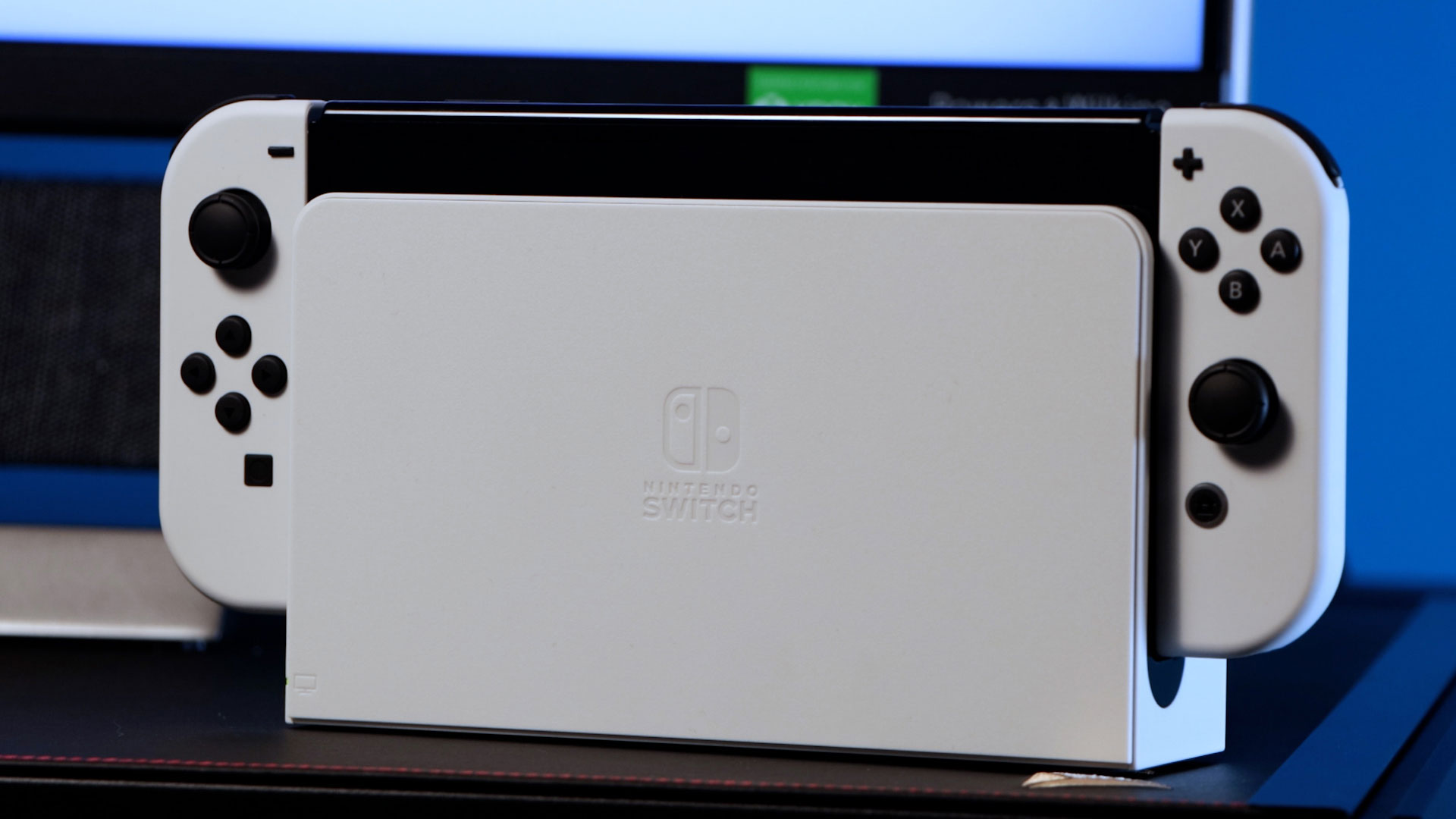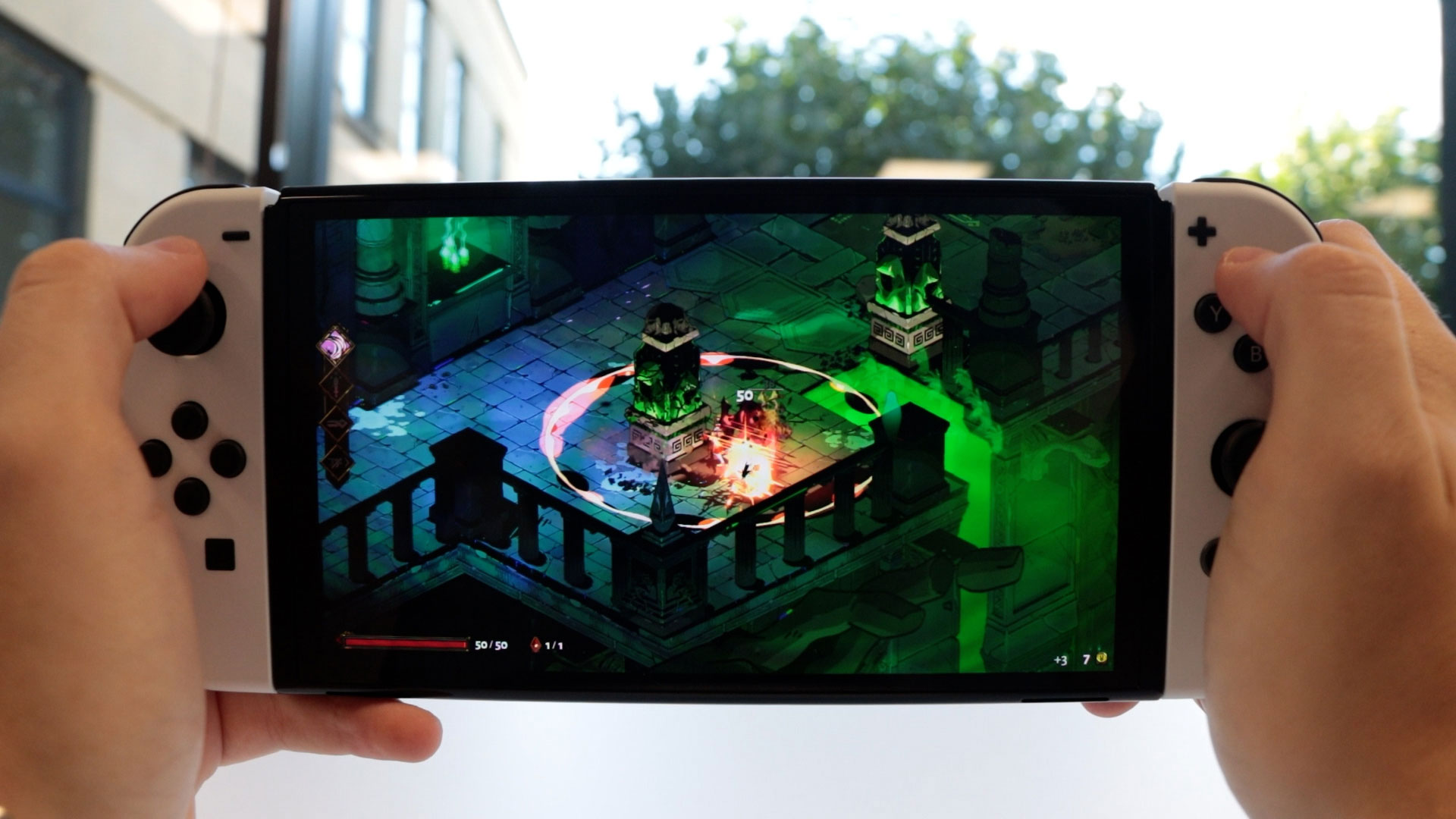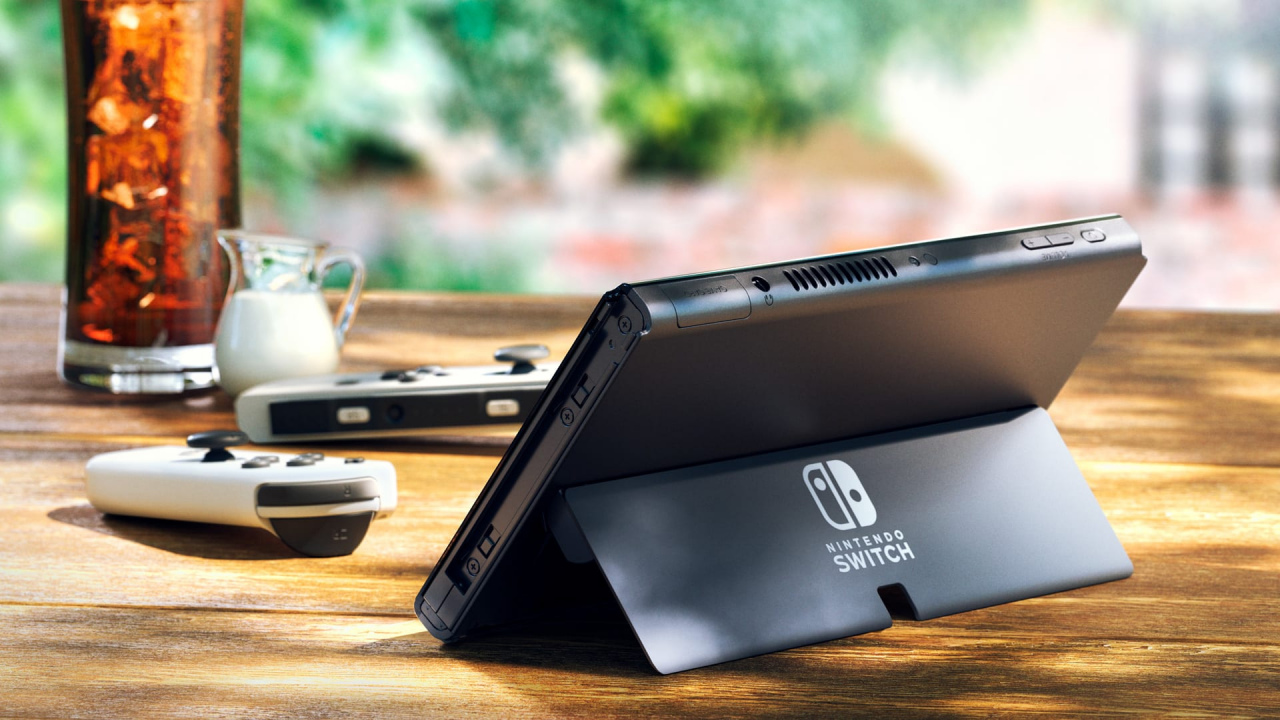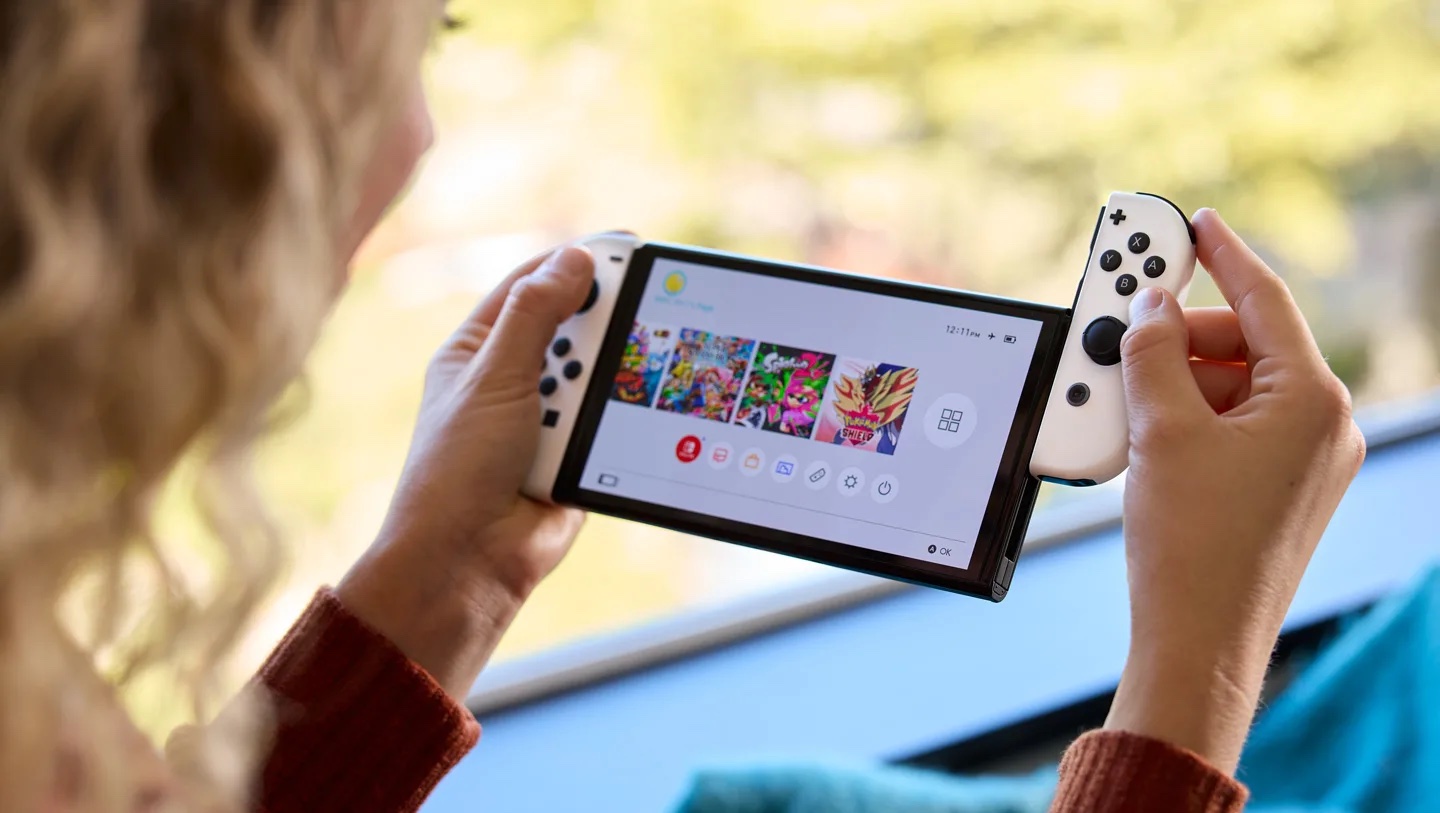GamesRadar+ Verdict
The Nintendo Switch OLED is a beautiful machine that lacks enough compelling new features to make it a must-recommend.
Pros
- +
Bigger, more beautiful display
- +
New features are great tweaks
- +
White colorway is sophisticated
Cons
- -
Not enough distinguishing features
- -
OLED visibility is worse outdoors
- -
Still only runs in 720p on handheld, 1080p on TV
Why you can trust GamesRadar+
Looks aren't everything, the old saying goes, but when the Nintendo Switch OLED is this good-looking it's hard to deny that looks are definitely important. As the name suggests, the headline feature of this new Nintendo handheld upgrade is a positively stunning 7-inch OLED screen that dominates the console in a way that makes it feel so much bigger than the original Switch or its smaller sibling, the Nintendo Switch Lite. But when the initial lust fades to appreciation, it's easy to realize that good looks will only get you so far.
Features
But, my goodness… that screen. As you can guess from the name of this new model, it's all about that display, and for good reason. The Switch OLED takes the original 6.2-inch LED panel and swaps it out for a larger, 7-inch OLED panel. Both displays are 720p HD - with the dock boosting the resolution to 1080p HD - but the OLED panel makes such a huge difference despite the lack of resolution upgrade.
Firstly, it completely changes the way the Switch feels in your hands. Despite there only being a 0.8-inch size difference, the 7-inch display seems so much larger, completely dominating the front of the console. It's wonderfully immersive and makes a much larger difference to the Switch handheld experience than I imagined it would. Going back to the original Switch, or the Lite, suddenly the LCD display feels cramped, the bezels far too wide, and the colors so very muted.

Display: 720p handheld, 1080p docked
Price: $349.99 / £309.99
Color schemes: White / Neon
Battery life: 4.5 - 9 hours
OLED screens excel at color fidelity, offering up deeper blacks and a more vibrant, richer color palette, and the Switch OLED's display ticks all of those boxes. Despite the 720p resolution, games I'd played for hundreds of hours before felt shiny and new on the Switch, and somewhat crisper than before, particularly when it came to the likes of Super Mario Odyssey and Luigi's Mansion 3. Metroid Dread is downright stunning on the OLED, particularly taking advantage of the depth of the blacks. It truly is the best way to experience Switch games on the go.
However, frustratingly for a heldheld console, OLED panels struggle in direct daylight, which made trying to use the Switch outdoors even more difficult than the LCD panel (even in the cloudy days of a British October). The Switch has always struggled in outdoor lighting - as my many, many attempts to catch the sun while knee-deep in my Animal Crossing addiction during lockdown will attest to - but the Switch OLED definitely doesn't offer a solution for that particular problem.
Design

Aside from the screen, the Nintendo Switch OLED is almost identical in design to the original Switch - or more specifically the enhanced battery life model that was released in 2019. Same size, same dimensions, same features, new screen. But, thanks to some subtle design tweaks, it's the most premium of the Switch line-up. Like the 2019 model, the rear has a matte finish, but this is now home to a completely revamped kickstand. Gone is the thin and fragile prop of the original, replaced with a kickstand that runs the full width of the Switch's main body. This makes it far sturdier and less prone to knocks and wobbles than ever before, especially as Nintendo has added two discreet rubber feet to the bottom edge of the Switch to help aid that rigidity in tabletop mode. The sheer size of the kickstand within the rear panel of the Switch also improves the feel of the entire build of the console, making it feel far more solid as a machine during long sessions in handheld mode.

You'll still find a microSD slot hidden beneath the kickstand for adding to the internal storage. However, you won't necessarily need to reach for it straight away, as the Switch OLED offers double the internal storage capacity of any other, with 64GB included as standard - compared to the 32GB of the original Switch and the Lite.
The rear vents have also been repositioned to accommodate the kickstand too. They're more downwardly angled than before and are protected by a light mesh, which should hopefully help reduce clogging. My launch Switch can regularly sound like a jet engine with a high-intensity game, so it'll be interesting to see how the Switch OLED's design tweaks help it long term.

It also boasts much larger speakers on the front of the console, offering audio that's not only louder but crisper too for those headphone-free sessions. It's also worth noting that, thanks to a recent software update, the Switch OLED - along with all other members of the Switch family - has support for pairing Bluetooth headphones or bespoke Nintendo Switch headsets without the use of an unofficial dongle, which is a welcome relief for those who like to travel with their Switch.
There are other subtler design tweaks too though, with the power and volume buttons getting design tweaks that change the power button from a circle to a pill-shape for easier accessibility and streamlines the volume rocker somewhat. The OLED screen is a glass panel rather than the plastic of the original switch models and the Switch Lite, and the surrounding casing is a classy gloss metal too, which only helps the premium overall feel of the machine.
I'm also obsessed with the new white colorway of the Switch OLED. While it's also available with the original neon red and blue Joy-Cons, there's something about the particular shade of white with this edition that feels like a Switch for adults, even compared to the original greyscale option. Docked next to the PS5, there's a reassuring similarity between the two's color schemes that brings a TV set-up together. It's white with just a hint of grey, which is exactly what you'd want from a white console that you're going to be constantly handling.
The new white dock is also a nice touch. Much smaller than the original dock, it offers up rounded edges and a lightly textured surface that reduce its footprint next to your TV. The rear has a cute Pokeball-esque cutout for feeding wires through too, which was a cute surprise. Interestingly though, the only addition to the dock itself is an Ethernet port. There's no 4K upscaling here, with the dock only boosting games to the original 1080p HD when docked.
Performance

And that is a big part of the problem when it comes to actually recommend the Switch OLED. Aside from the screen and some design tweaks, you're looking at fundamentally the same console as its forebearers. It's enhanced and refined in certain areas, but there's no huge leap in graphics or performance to expect from the Switch OLED. It's disappointing and means there are few distinguishing features to truly separate this shiny new machine from the Switch consoles already available - and for a considerably lower price.
After four years on the market, this feels like it should be the perfect time to launch a Nintendo Switch Pro, bumping the handheld resolution up to 1080p with 4K support when docked. But this is still a 720p display. A more impressive one, yes, but when its competitors - including the upcoming Steam Deck - are offering 4K resolutions on your TV, it does feel like the Switch is being left behind.

The internal hardware specs are the same too, so don't expect to find any differences when it comes to loading times or framerates stability if you're upgrading from an existing Switch model. An Animal Crossing: New Horizons island laden with items and custom content is still going to struggle on the Switch OLED, even if it does look more impressive than before.
One thing that anyone that is upgrading from a launch Switch will notice is an increase in battery life. The 2019 model added an extra three hours of battery life to the launch model, bumping it up to anywhere between 4.5 - 9 hours depending on what you're playing, and the Switch OLED packs the same cell. With Metroid Dread, for example, I got a solid 6 hours from a single charge. But if you're snatching an hour here and there of an evening, the Switch can easily be left on Rest Mode for multiple days without fretting over battery life.
Should you buy the Nintendo Switch OLED?

So, while the Nintendo Switch OLED is clearly the best version of the console so far, it's also the most complicated to recommend. Your decision on whether to invest will entirely depend on your current Switch status and your budget.
The premium Switch experience is the OLED, but that comes with the accompanying price tag. By far the most expensive Switch to date, the latest console is priced at £309.99 / $349.99, while the 2019 edition Switch is now £259.99 / $299.99 - having just received a permanent price cut in Europe. That means that you're looking at paying £50 / $50 more for the OLED's beautiful screen and some design tweaks, but not a lot else.

For anyone who hasn't invested in a Switch yet, the OLED display does enough to make it the best example of everything the Switch has to offer to date. However, unless you're an absolute display panel snob, you're also not going to be mad at saving or the screen on the original Switch - especially if you're looking to play it docked regularly, and thus not always utilize that OLED loveliness. You could also pick up a Switch Lite for £199.99 / $199.99 if you're not bothered about docking the console or the removable Joy-Cons (which are also sold separately if you changed your mind on that later). It's a great handheld-focused console, at the most affordable price.
For those who have already invested in the Switch ecosystem, it's a different story though. If you're rocking a launch Switch that's running well or the 2019 model, it's going to be hard to justify the OLED upgrade. While you will ooh and aah over that new display and how it can transform the look and feel of your Switch games, there really just aren't enough differentiators to make it an essential upgrade.

Sam Loveridge is the Brand Director and former Global Editor-in-Chief of GamesRadar. She joined the team in August 2017. Sam came to GamesRadar after working at TrustedReviews, Digital Spy, and Fandom, following the completion of an MA in Journalism. In her time, she's also had appearances on The Guardian, BBC, and more. Her experience has seen her cover console and PC games, along with gaming hardware, for a decade, and for GamesRadar, she's in charge of the site's overall direction, managing the team, and making sure it's the best it can be. Her gaming passions lie with weird simulation games, big open-world RPGs, and beautifully crafted indies. She plays across all platforms, and specializes in titles like Pokemon, Assassin's Creed, The Sims, and more. Basically, she loves all games that aren't sports or fighting titles! In her spare time, Sam likes to live like Stardew Valley by cooking and baking, growing vegetables, and enjoying life in the countryside.



